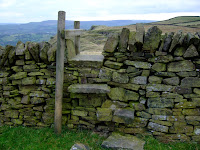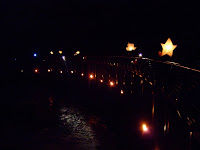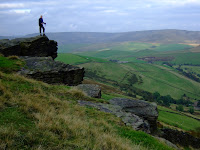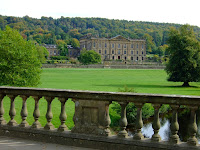
 The persistent pull of the Peaks again persuaded us to perambulate purposefully across the pleasant pastures, progress past the proudly protruding promontories and pass by poignant pointers to past periods.
The persistent pull of the Peaks again persuaded us to perambulate purposefully across the pleasant pastures, progress past the proudly protruding promontories and pass by poignant pointers to past periods. Leaving the motorway, a pleasant drive across Derbyshire took us to New Mills. This is a town with a fascinating legacy of mills, left from the industrial era. There is an excellent display in the Heritage Centre, with a model of the town as it was, with its many mills.
Leaving the motorway, a pleasant drive across Derbyshire took us to New Mills. This is a town with a fascinating legacy of mills, left from the industrial era. There is an excellent display in the Heritage Centre, with a model of the town as it was, with its many mills. Today there are a few mills left, and we started our 8-mile walk with the Millennium Walkway through the gorge, which still has a large derelict mill complex,
Today there are a few mills left, and we started our 8-mile walk with the Millennium Walkway through the gorge, which still has a large derelict mill complex,  many picturesque bridges and other ruins. The walkway is an impressive cantilevered bridge, as we reached the end we met a group of people setting up lanterns over and around the river. It transpired that we had arrived on the night of their annual lantern procession.
many picturesque bridges and other ruins. The walkway is an impressive cantilevered bridge, as we reached the end we met a group of people setting up lanterns over and around the river. It transpired that we had arrived on the night of their annual lantern procession. We continued on the walk, which had a pleasant canal section; including the remains of an old limestone processing terminus, and an interesting hill walk past many quarries, with marvellous views over the surrounding countryside.
We continued on the walk, which had a pleasant canal section; including the remains of an old limestone processing terminus, and an interesting hill walk past many quarries, with marvellous views over the surrounding countryside. We didn't complete the walk until 6.30pm, so had a quick meal at an excellent Indian Restaurant, and at 7.30 joined the 3000 or so people walking in a long procession over the Millennium Walkway and on to a fireworks display. It was a lovely family event, with an eclectic
We didn't complete the walk until 6.30pm, so had a quick meal at an excellent Indian Restaurant, and at 7.30 joined the 3000 or so people walking in a long procession over the Millennium Walkway and on to a fireworks display. It was a lovely family event, with an eclectic  collection of hand made lanterns of many different shapes and sizes. Fish were most popular, with some very terrifying jaws type creatures. There were many other imaginative designs including watering cans, a sea-horse, jellyfish, ships, stars and even a cup & saucer.
collection of hand made lanterns of many different shapes and sizes. Fish were most popular, with some very terrifying jaws type creatures. There were many other imaginative designs including watering cans, a sea-horse, jellyfish, ships, stars and even a cup & saucer. Leaving after the parade we confirmed our decision that New Mills is a sat-nav black-hole. On the way in, the sat-nav attempted to take us up and over a non-existent road into New Mills from the south. As we left, heading north in the dark, on the way to our accommodation, we found ourselves turning sharp left on to a road, which seemed to us to simply be
Leaving after the parade we confirmed our decision that New Mills is a sat-nav black-hole. On the way in, the sat-nav attempted to take us up and over a non-existent road into New Mills from the south. As we left, heading north in the dark, on the way to our accommodation, we found ourselves turning sharp left on to a road, which seemed to us to simply be  a pub carpark. Oh well, no one said technology was perfect!
a pub carpark. Oh well, no one said technology was perfect!The Peak District is, reportedly, the second most visited National Park in the world (after Mt Fuji), so no wonder we find it keeps drawing us back.
 We started Sunday with a 7-mile walk across the moors and around one of the many rock outcrops, called Edges. The views, again, were stunning. The walk finished by passing through parts of the Chatsworth Estate. Aptly known as the Palace of the Peaks, the house is palatial and the park-like grounds are lovely.
We started Sunday with a 7-mile walk across the moors and around one of the many rock outcrops, called Edges. The views, again, were stunning. The walk finished by passing through parts of the Chatsworth Estate. Aptly known as the Palace of the Peaks, the house is palatial and the park-like grounds are lovely. Our second tour of the day was a complete contrast to the grandeur and luxury of Chatsworth: The Workhouse at Southwell. En-route we stopped in the pleasant town of Chesterfield, to have a look at the church with a twisted spire. It wasn't always so, it started life straight and remained that way for several centuries before it twisted. Legend has it the spire twisted as it turned round in amazement when a virgin was married in the church. The spire leans a little further every year and the top is now 9ft off centre
Our second tour of the day was a complete contrast to the grandeur and luxury of Chatsworth: The Workhouse at Southwell. En-route we stopped in the pleasant town of Chesterfield, to have a look at the church with a twisted spire. It wasn't always so, it started life straight and remained that way for several centuries before it twisted. Legend has it the spire twisted as it turned round in amazement when a virgin was married in the church. The spire leans a little further every year and the top is now 9ft off centre Then on to Southwell: the town has a magnificent minister, also well worth a visit; but today we did a tour of The Workhouse. This was the first prototype Workhouse in England. The poor had always been the responsibility of each parish council. This proved to be an expensive problem for them, and added considerably to taxes.
Then on to Southwell: the town has a magnificent minister, also well worth a visit; but today we did a tour of The Workhouse. This was the first prototype Workhouse in England. The poor had always been the responsibility of each parish council. This proved to be an expensive problem for them, and added considerably to taxes.The Reverend Beecher came up with the Workhouse principal, and when he was able to demonstrate it, it worked. In 1824 The Southwell Workhouse was built, and proved to be a working model many other parishes adopted. The idea was to look after the young, old and infirm (the deserving poor) fairly but firmly.
 The able-bodied (the idle poor) were made to work hard at menial tasks for no pay, in the hope of encouraging them to leave again promptly. "A well run Workhouse is an empty Workhouse". Having read of workhouses in historical novels, it was an extremely interesting tour. It was also disturbing to note that these places, that one thinks of as Dickensian, were used up until the 1950s.
The able-bodied (the idle poor) were made to work hard at menial tasks for no pay, in the hope of encouraging them to leave again promptly. "A well run Workhouse is an empty Workhouse". Having read of workhouses in historical novels, it was an extremely interesting tour. It was also disturbing to note that these places, that one thinks of as Dickensian, were used up until the 1950s.(As you may have guessed from the quality of the pictures, our Fujifilm f30 has been repaired under warranty and returned.)




No comments:
Post a Comment